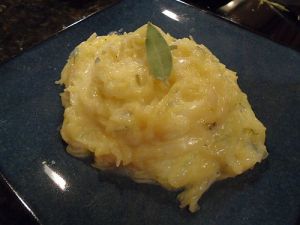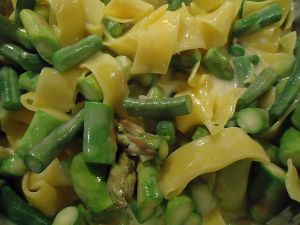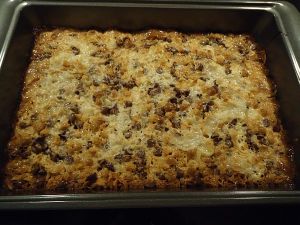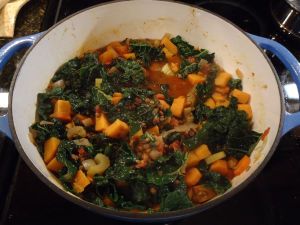[Winter Squash, Part 2]
After finishing off the last of the spaghetti squash, I decided to tackle the butternut squash that you can see lurking there in the background. Weighing in at over 5lbs, it was an impressive specimen! I’ve always liked butternut squash (despite the lack of recipes featuring it on this blog!), and I frequently use it in any recipe that calls for pumpkin, since it’s often more readily available than pie pumpkins. This time, though, I wanted to do something a bit different.
Inspired by Smitten Kitchen’s various squash salad applications (for example this or this), I decided to make up my own. I contemplated various beans and grains before deciding on using red lentils because a) we had some in the pantry and b) you don’t have to soak them overnight. Along with the squash and lentils, I decided to roast a few shallots that had been rolling around in the bottom of the fridge, and to top the whole thing off, I went with some feta, parsley, and toasted hazelnuts. Of course the feta turned out to be the wrong kind for crumbling, but since the salad was warm, I rather liked how it melted and mingled with the squash and lentils.
So much for the main ingredients, but what about spices? Normally I probably would have gone with a bolder spice palette, and no doubt would have added a healthy dose of cayenne pepper (or even added some fresh cayenne peppers for that matter–we had quite the haul this year from our balcony garden!) but alas, since pregnancy has given me the gift of heartburn, I had to get a bit more creative with my flavors. In the end, I decided to roast the squash and shallots together with some whole cumin seeds and a bit of salt, and to cook the lentils with a cinnamon stick, bay leaf, and some black peppercorns, as well as a couple of tablespoons of tamari soy sauce (which is my favorite trick for imparting flavor to any sort of bean/grain/rice). I also created a simple vinaigrette with olive oil, rice vinegar, and tamari–the acid from the vinegar definitely brightened up the dish, although in retrospect a bit of lemon juice would have been very nice too.
In the end, this dish turned out to be one of the best applications of butternut squash that I’ve ever made–it managed to be filling without being heavy, spiced without being spicy, and it was pretty easy to pull together with a fairly minimal amount of pre-planning. It also made enough to feed a small army, and the leftovers tasted just as good cold as warm. I think this dish is definitely going to be a permanent addition to the fall meal rotation.
Warm Salad with Cumin Roasted Butternut Squash and Spiced Lentils
(Serves 6-8)
For the squash:
- 1 large butternut squash (approx. 5lbs)
- 1-2 large shallots
- 3 tbsp grapeseed oil
- 2-3 tbsp whole cumin seeds
- 1/2 tsp kosher salt
For the lentils:
- 1.75 c red lentils
- 3.25 c water
- 1 cinnamon stick
- 1 bay leaf
- 9 whole black peppercorns
- 2 tbsp tamari soy sauce
Dressing:
- 5 tbsp olive oil
- 3 tbsp rice vinegar or lemon juice
- 1 tbsp tamari soy sauce
- a few grinds of black pepper
Toppings:
- 1/4 c crumbled feta cheese (or finely diced if your feta doesn’t crumble)
- 1/4 c hazelnuts, toasted and peeled
- small handful of fresh parsley, chopped
Preheat the oven to 350 degrees and spread out the hazelnuts on a parchment-lined sheet pan (the kind with edges so they don’t roll off!). Put them on the middle rack and toast for 8-12 minutes, giving them a good stir halfway through. You’ll be able to smell when they’re done–don’t burn them! Remove the hazelnuts from the oven, and turn up the heat to 400 degrees in preparation for the squash. Allow the hazelnuts to cool for a bit. Then take the corners of the parchment and bring them together, creating a little package. Wrap the whole thing in a towel, and rub it around until the nuts are mostly peeled (they don’t need to be perfect).
While the hazelnuts are toasting, peel your butternut squash, halve it lengthwise and scoop out the seeds, and then cut it up into 1-inch cubes. Peel the shallot(s) and cut into large chunks. Line the sheet pan you used for the hazelnuts with aluminum foil, and spread out the squash and shallots in a single layer. Drizzle the grapeseed oil over everything and then sprinkle on the cumin seeds and salt. Mix it all together with your hands, making sure that all the pieces of squash are coated in oil, spread them back out, and then put it in the oven (which should now be at 400) for 20-30 minutes or until the squash is fork tender but not disintegrating.
Once the squash is going, rinse and pick over your lentils and then add them to a pan with the water, tamari, cinnamon stick, bay leaf, and peppercorns. Give it a good stir and bring it to a boil. Then reduce the heat and simmer until the lentils are fully cooked–probably about 20 minutes.
While the lentils and squash are cooking, whisk together all of the dressing ingredients in a small bowl. Taste, and adjust the ratio of vinegar/lemon juice to oil as needed. You may end up wanting to sprinkle a bit more lemon juice or vinegar over the finished salad if the acidic flavor gets lost in the squash and lentils.
Once the lentils are done, drain off any excess water, and pull out the cinnamon stick, bay leaf, and (if you can find them) the peppercorns. (If you can’t find them, just chew carefully!) Put the lentils in a large serving bowl along with the squash and shallots. Mix them together, and then pour on the dressing and add the toppings. Give everything a good toss, add extra vinegar, lemon juice, or salt to taste, and serve immediately.
Enjoy!








































